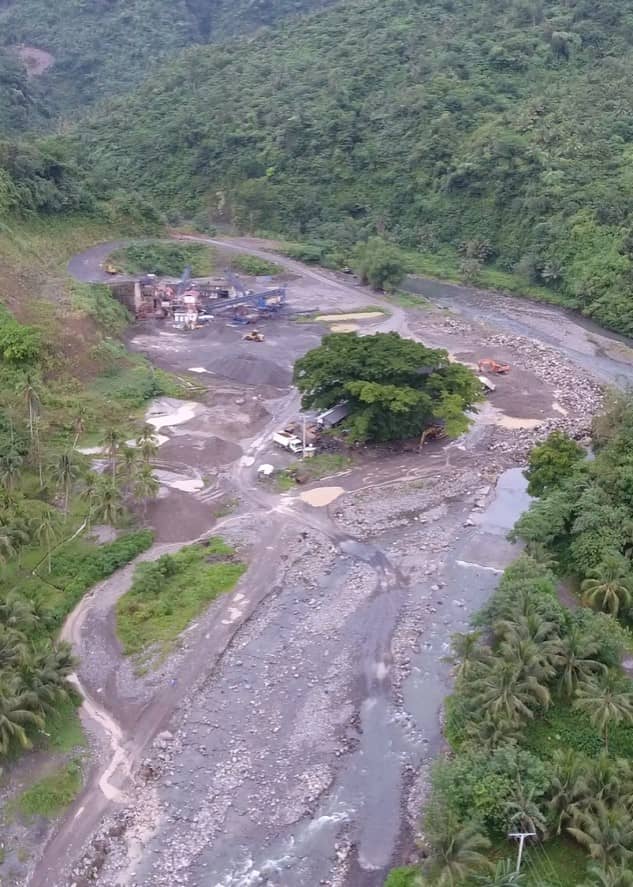
ISSN: 2286-7511
E-ISSN: 2287-0113
The Anti-Trafficking Review promotes a human rights-based approach to anti-trafficking. It explores trafficking in its broader context including gender analyses and intersections with labour and migrant rights.

ISSN: 2286-7511
E-ISSN: 2287-0113
The Anti-Trafficking Review promotes a human rights-based approach to anti-trafficking. It explores trafficking in its broader context including gender analyses and intersections with labour and migrant rights.
Merry Jean A. Caparas and Maria Aurora Teresita W. Tabada
As the climate emergency intensifies in the Philippines, extreme weather events increasingly threaten key economic sectors. In response, the government has prioritised infrastructure development, driving up demand for sand and gravel from the extractive industry. This article shares the story of a small agricultural village that was devastated by a super typhoon, forcing rice farmers to sell their land and leading to a rapid expansion of sand and gravel extraction. This situation now endangers the village’s irrigation system, its lifeline for farming. The narrative highlights a critical dilemma: while rebuilding after climate disasters necessitates urgent infrastructure development, extractive industries can exacerbate the vulnerabilities of rural communities.
Suggested citation: M J A Caparas and M A T W Tabada, ‘Fields of Uncertainty: Climate, extraction, and the struggles of rice farmers in the Philippines’, Anti-Trafficking Review, issue 25, 2025, pp. 165-170, https://doi.org/10.14197/atr.2012252511
The Philippines is ranked among the most vulnerable countries to extreme weather, according to reports such as the 2025 Climate Change Performance Index.[1] In response, the government launched the Build, Build, Build programme in 2017—now rebranded as Build, Better, More—to drive economic growth while addressing climate concerns through infrastructure development. However, this initiative has also intensified the extraction of sand and gravel (SAG), compounding the difficulties faced by farmers already burdened by climate-related impacts. As a result, they are increasingly caught in cycles of precarious labour, further deepening both economic challenges and ecological strain.
In 2017, the National Irrigation Administration (NIA) Region 8 reported that SAG extraction in Leyte affected 5,143 hectares of farmland, reducing rice production by 41,144 metric tonnes—a loss valued at PHP 699,448,000 (USD 18,689,020), impacting 207,449 farmers. This surge in SAG extraction is widely attributed to the infrastructure rebuilding efforts following Super Typhoon Haiyan in 2013, which also caused severe devastation to agriculture and irrigation systems. With recovery and repairs proving slow and costly, farmers struggled to sustain their livelihoods. Many were left with little choice but to sell their land, including agricultural fields situated near rivers, which subsequently became prime sites for SAG extraction.
The repercussions of SAG extraction are particularly pronounced in rural areas with high to medium poverty rates, such as Barangay [village] Salvacion in the municipality of Albuera. Home to the Bacan River, this area relies heavily on farming and hosts the Magbangon Communal Irrigation System (MCIS), which supports rice farmers across 140 hectares. The heavy SAG extraction in the river alters its physical characteristics, increasing flood risks during extreme weather and threatening the irrigation infrastructure and rice farming livelihood.
In 2018, while engaging with the irrigators’ association in Albuera, we were invited by Manong [Mister] Juan (pseudonym), a member of a local irrigators’ association, to attend a public hearing for a mountain quarry application in Barangay Salvacion by a prominent local construction company. The public hearing was attended by the permit applicant, municipal representatives, members of the Provincial Sand and Gravel Task Force, and barangay residents.
Before the hearing, Manong Juan warned that barangay residents had been offered PHP 500 (USD 14) by the permit applicant for their signatures, raising concerns about support for the proposal. In the Philippines, mining and non-metallic resource extraction applications require area clearance from local government units, including barangays. Community consent is based on signatures in favour of the application and the absence of major opposition. This requirement is outlined in Chapter VIII of the Department of Environment and Natural Resources Administrative Order (DAO) 2010-21.
Despite being on edge, Manong Juan objected to the application during the public hearing, citing irrigation degradation and increased sediment in the river. He emphasised legal restrictions prohibiting extraction within a one-kilometre radius of irrigation infrastructure. However, the permit applicant interrupted, defending their company’s role in community support and highlighting desilting efforts to improve water flow for MCIS, especially after floods. Their response was met with audience applause, showing approval and appreciation for the company’s contributions. This reaction put Manong Juan at a disadvantage, as community support overshadowed his warnings about environmental risks.
Constitutionally, permit holders of extraction activities in the Philippines must implement a Social Development and Management Program to support host communities, as mandated by Chapter XIV of DAO 2010-21. This assistance is not generosity but an obligation, ensuring residents benefit after commercial extraction of state-owned resources within their jurisdiction.
After Manong Juan’s unsuccessful attempt to resist the new SAG extraction application in Barangay Salvacion, he invited us to walk along the Bacan River towards the upstream portion where the MCIS is located. Upon entering the riverbank, we noticed a guard post with a man watching us. Manong Juan told us to ignore him and continue walking. We moved away from the river and followed a trail beneath the shade of a coconut plantation. Pointing to the surroundings, he shared that he and his siblings once owned the land adjacent to the river, inherited from their parents. They had negotiated with the SAG permit holders for payment for the right of way, as backhoes and trucks carrying aggregates damage their crops. However, they had never received any payment and eventually decided to sell their land to one of the permit holders.
The story of Manong Juan is just one of many cases illustrating how those directly affected, often farmers, have little recourse and are forced into unfavourable negotiations. This dynamic reinforces the dominance of permit holders over critical local concerns such as livelihoods, ultimately leading to dispossession. His experience exemplifies a broader pattern of systemic exploitation, where communities struggle to secure rightful compensation for damages and remain powerless against industry-level extraction operations.
We continued our walk along the river. Finally, the guard post had disappeared into the distance. Not far from us, we saw an acacia tree. Close to it were piles of SAG ready for transport. Part of the river was almost dry, and just as we realised that we were looking towards the irrigation infrastructure, we understood that the presence of the guard had been no coincidence. This area was shielded from the public or unannounced inspections, controlled by permit holders whose activities seemed to extend beyond what is lawfully allowed.
Permitted extraction is legally required to follow strict regulations, including quarterly inspections led by the Mines and Geosciences Bureau. Permit holders must submit sworn reports detailing the materials extracted and disposed of, ensuring transparency and environmental responsibility. Yet, the Bacan River’s condition reveals significant issues. Extraction has disrupted water flow to the irrigation system, threatening its stability. In cases of heavy flooding, the disturbed riverbed could lead to disaster. By 2021, NIA declared that excessive SAG extraction had damaged or washed out four irrigation systems out of seven irrigation infrastructures in Albuera, drastically altering the river’s natural channel and intensifying floods, making water movement dangerously unpredictable.

Image 1. Location of the Magbangon Communal Irrigation System. Photo taken in September 2018 by the project team of which the authors were part.
At the February 2019 forum organised by Visayas State University’s Institute for Strategic Research and Development Studies in partnership with NIA, the then Municipal Mayor of Albuera said, ‘Albuera was just a very simple agricultural community. Relying so much on farms for a living. From there, we learnt to maximise the land by employing technology to increase production and ultimately our income. Thus, the Albueranos decide to tap their very own environment to fulfil that dream. So, yes, Albuera is facing the greatest challenge of combating the very effect of our very own dream. Our problem with extractive industries is getting worse.’
But was it ever the dream of the Albueranos to commodify their riverbeds? While the exact turning point remains unclear, most agree the industry surged in 2014 and 2015, following Super Typhoon Haiyan’s devastation in 2013. The disaster crippled irrigation and agriculture, forcing rice farmers to sell their land. Initially, SAG extraction was a financial lifeline amid the crisis. However, it then evolved into a threat to rice farming. As storms and typhoons become more frequent due to the climate crisis, the risk of flooding looms ever larger, endangering critical irrigation infrastructure and deepening farming communities’ vulnerability.
Through our engagement with the community, NIA, and the Mines and Geosciences Bureau, we uncovered that SAG permit holders in the Bacan River area are operating businesses and living outside Albuera, with most workers coming from outside the town. A deeper investigation into these permit holders revealed a concerning pattern: most belong to a single family, each holding individual commercial permits under separate names. This allows them to evade the stringent requirements set for large-scale commercial applications while maintaining access to different areas of the river.
At another public hearing in a neighbouring barangay, Manong Isidro (pseudonym), also a member of a local irrigators’ association, recounted a troubling event. Initially, only 11 out of 70 community participants supported the extraction application. On the following day, the applicant returned and promised people money, influencing them to change their decision and cast additional votes in favour. He explained: ‘The situation is becoming harder because the community is not cooperating at all. Those few who continue to oppose the operation are being threatened’.
The ongoing SAG extraction, which threatens both irrigation systems and agricultural rice fields, has become a major concern for residents. The phrase ‘We will soon eat sand and gravel’ has grown common in the town of Albuera, reflecting deep anxieties over the industry’s impact. In response, many of the irrigators’ associations in Albuera, including those of Manong Juan and Manong Isidro, organise themselves through the support of NIA and submit petitions to the Office of the President and the Department of Environmental and Natural Resources. However, their fight is far from over, as the extractive industry remains deeply embedded in the country’s development plans.
This story reflects a pressing dilemma in managing the climate crisis, particularly in the Global South, where extreme weather events are increasingly severe and frequent, and the recovery process remains slow. On one hand, the urgency to rebuild after climate-related disasters demands rapid infrastructure development to protect lives and restore essential services. On the other hand, when such development is pursued without regard for local realities, it can deepen existing vulnerabilities and expose marginalised communities to even greater climate risks. This raises a difficult but necessary question: whose climate emergency takes precedence? Perhaps the real challenge lies not in choosing between national development and local resilience, but in recognising that they must be addressed together, ensuring that responses do not come at the expense of those most at risk.
Merry Jean A. Caparas is currently pursuing a joint PhD at La Trobe University, Australia and Sheffield Hallam University, UK. She holds a Master of Science degree in Sociology and Water Management and Governance, and was previously a research assistant at the Visayas State University, the Philippines. Email: M.Caparas@latrobe.edu.au
Maria Aurora Teresita W. Tabada is an Associate Professor of Sociology at Visayas State University, with intensive work on community-based natural resources conflict management, particularly on water and mining. Email: tess.tabada@vsu.edu.ph
[1] The index uses a standardised framework to assess and compare the climate performance of 63 countries and the European Union, based on four key categories: Greenhouse Gas Emissions, Renewable Energy, Energy Use, and Climate Policy. In the 2025 ranking, the Philippines placed 7th overall. See: J L Algo et al., ‘Climate Change Performance Index – Philippines’, Germanwatch, NewClimate Institute, Climate Action Network International, November 2024, retrieved 26 May 2025, https://ccpi.org/country/phl.